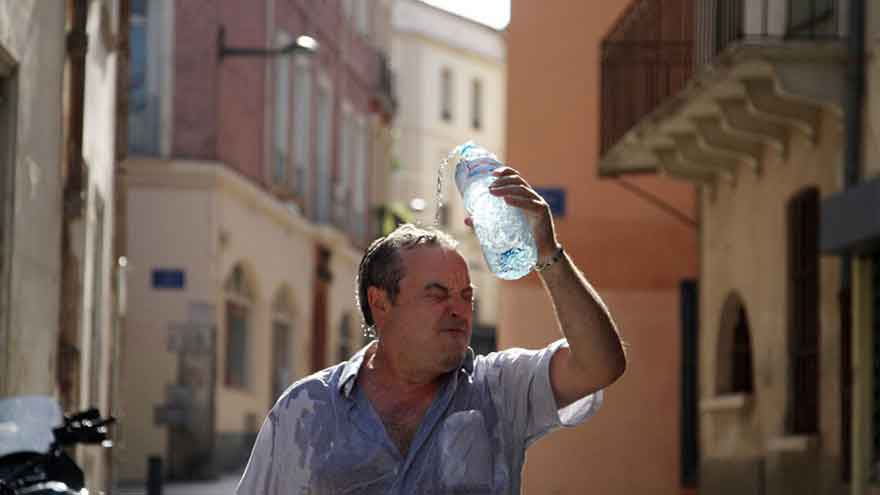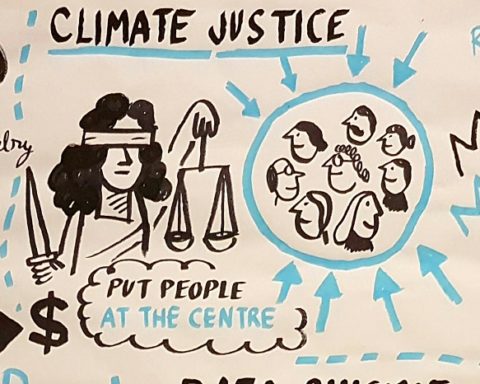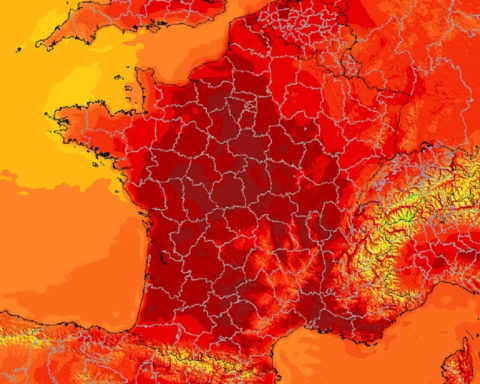2003, the summer of awareness
Daily weather conditions such as temperature and humidity have a role on our health that has long been known, but which became apparent to the general public during the heat wave in the summer of 2003: temperatures above 35°C were then observed by two thirds of Météo France stations between the 1st of July and the 1st of September.er and on 18 August; maximum and minimum temperatures were the highest since 1950; the night temperature remained high, above 25°C in Paris for two consecutive nights, preventing the body from recovering at night from daytime heat stress, all this in conjunction with high levels of ozone pollution.
On August 10, when the heat wave had already been underway for more than a week, an emergency doctor from a major Parisian hospital, Dr. Patrick Pelloux, sounded the alarm in the media, announcing that the emergency rooms were overwhelmed and working in impossible conditions; he spoke of a hecatomb, citing the figure of about fifty deaths due to the heat wave. The funeral services also indicated that they were overwhelmed. Refrigerated halls at Rungis Market were requisitioned for emergency use as burial chambers. On 13 August, the white plan, which enabled doctors and hospital beds to be requisitioned, was triggered by the authorities in the Île-de-France region.
On August 17, the Ministry of Health denied the hypothesis of 5,000 excess deaths then announced by Dr. Pelloux, before indicating on August 18 that a figure of 3,000 to 5,000 was finally plausible. The Director General of Health was forced to resign. On August 20, a group of undertakers estimated that the number of excess deaths since the beginning of August was in the order of 13,000, a number which the government could not confirm, calling for "caution".
In fact, the excess of deaths in August 2003 over the average of previous years was about 15,000 for the country as a whole. Île-de-France and many cities were affected, while the Lille and Le Havre conurbations were spared excess mortality. Europe-wide, the number of deaths caused by the summer 2003 heat wave is estimated at around 70,000, making it one of the deadliest of those whose effects have been documented.
A loss of life expectancy
The magnitude of the effect seems to have depended on many environmental (urban heat islands, density of green spaces, air conditioning, etc.), social and behavioural factors. It was not just a very short-term displacement of mortality (this would have happened if only very sensitive populations or populations with other pathologies had been affected by the heat wave, and if the excess mortality during the heat wave had been compensated in the following weeks by an under-mortality. Such under-mortality relative to the average was not observed in the months following the heat wave). A real decrease in life expectancy therefore occurred.
The 1976 heat wave caused 6,000 excess deaths across the country. Not all of these deaths were "hot flashes" or severe dehydration, and are therefore not identified as heat-related by death certificates (the situation is the same for air pollution and most other environmental factors). Many of them correspond to what can be seen as the decompensation of underlying pathologies (cardiovascular, respiratory, renal...): the heat wave is the additional factor that triggers the occurrence of a death with multiple causes.
Heat waves: health consequences long underestimated
In France, this heat wave confirmed or revealed several fundamental things. The first is that heat kills and can do so consistently - this "environmental" factor was not really on the radar of the health and environmental authorities. At the time, there was no health agency or health-related government department in France that was really responsible for "monitoring" the occurrence of a heat wave. There was no coordination set up between Météo France and a health agency, a situation that has since changed.
The second is that the heat wave does not only affect very fragile subjects who are already hospitalized, on the contrary. Three-quarters of the deaths occurred at home, not in hospital, probably due to the fact that those already hospitalized were well monitored and hydrated by medical personnel. The fight against heat waves in our country is a problem of prevention - as long as we don't weaken the health care system. The situation follows the same logic for people living in retirement homes. Alfred Spira's team has shown that, among the elderly living in institutions, the effect of the heat wave was more pronounced among those in good health. than in those who were in poorer health before the heat wave began....
Lesson three: the authorities are, then, not able to monitor the mortality of the population in real time. It is the emergency services, the police, the fire brigade and the funeral services that sound the alarm, with estimates that are patchy and often, logically, far from reality. The situation is different in the United Kingdom where, since the XVIIe century, mortality data are available in less than a week. A dozen years later, France still does not have the means to comprehensively monitor nationwide deaths in real time or with a time lag of the order of a week; the electronic death certificate project could help improve the situation. A death tracking system called Sursaudwas set up by Public Health France and allows rapid reporting of mortality data for approximately 80 % of the population, in addition to centralizing data from 600 emergency services.
In the face of the weather, all populations are not equal...
The influence of weather is not limited to extreme events, but also includes is also observed during seasonal fluctuations. Thus, using a time series approach, a U-shaped relationship between temperature and mortality can be observed, with increased mortality at the coldest and warmest temperatures.
The thermal optimum (generally between 15 and 25°C), and therefore the thresholds above which the risk of death increases, varies according to the population: populations in southern Europe, for example, are more sensitive to the effects of cold than those in the north, and those in the north to heat. This can probably be explained by each population's adaptation to the local climate, through lifestyles that are more or less effective in protecting against heat or cold, in terms of heating, insulation, protection against the sun, solidarity, etc.
That doesn't mean you can resist everything. When we describe the influence of temperature on mortality as a function of the temperature distribution in each city, we realize that people in American cities and countries like Australia start to suffer (in terms of mortality) from heat when it reaches the 10 % warmest temperatures. In Spain, on the other hand, the risk of mortality increases much earlier, as soon as the median temperature (the one observed or exceeded on half of the summer days) is reached. We will come back to the issue of adapting to heat waves. In addition, the effect of temperature on mortality is modified by humidity, which tends to amplify it.
The effects of temperature on health
The mechanisms by which temperature influences health are, on the one hand, biological effects on the organism, on the other hand, effects on the environment and finally on behaviour.
Concerning the environment and behaviours, the cold can for example favour intoxication by carbon monoxide from boilers, injuries related to ice, as well as the transmission of certain epidemics due to viruses that survive better in the cold and dry weather typical of winter.
The more direct biological effects concern the cardiac, respiratory, endocrine, immune and nervous systems. Effects of meteorological factors on pregnancy outcomes are also plausible. In particular, low air pressure is known to be a risk factor for low birth weight; this has been known for a long time, following the finding that children born in the state of Colorado (much of which is at high altitudes, i.e. at lower air pressure than at sea level) are more likely to have a low birth weight. An effect of meteorological parameters, particularly temperature, on the risk of premature birth, has also recently been suggested.
A word about preventing the health effects of temperature: unlike the fight against air pollution, in which improving the quality of the environment is difficult to circumvent, a large part of the effects of temperature on health can be limited by simply protecting the body, without necessarily affecting the environment. In the case of the fight against heat waves, cooling the body for a few hours a day is enough to mitigate a large part of the health effects. The recommended preventive measures include hydration, limiting physical exercise and staying outdoors during the hottest hours.
It is striking to note that, in our country at least, most of these measures correspond to individual recommendations; there are apparently no measures aimed at local and regional authorities today. However, local authorities have many levers in their hands: opening swimming pools for longer periods and at lower cost, watering the streets, making air-conditioned places more accessible... Such measures are complementary to individual recommendations, and could be. There is a lack of hindsight on the measures that are the most effective, but some cities have started to adopt "heat wave plans" (such as Grenoble), beyond the National Heat Wave Plan. These measures seem to be overwhelmingly focused on short-term prevention, while longer-term actions could also be useful to make our societies more resilient to heat waves: greening cities and increasing the reflection of soils and roofs are among the solutions being implemented abroad, and providing communities with a full picture of the range, effectiveness and cost of the different options available to them would be important.
Adapting to climate change?
Climate change is likely to lead to an increase in the frequency of such extreme weather events (hot or cold waves, storms). A trend in the French population to better withstand heat waves since 2003, was found. This adaptation is probably due to changes in behaviour towards the elderly and other changes in our society, rather than physiological processes. It does not mean that societies are or will be able to fully compensate for the effects of climate change by increasing the frequency of heat waves; more importantly, it is very likely that not all societies will be able to do so.
Initial evidence suggests that adaptive capacity - the resilience of societies, urban areas - to the heatwave actually varies from region to region.. For example, this work suggests that, over the period 1993-2006, cities in Japan or the United States have become less sensitive to heat waves, while this is apparently not the case for cities in the United Kingdom. Data covering the whole of the XXe century are particularly available for New York City.. They indicate that the effect of a 29°C temperature on mortality on a given day corresponded to an increase in mortality of about 43 % in the years 1900-1909 (with a 95 % confidence interval ranging from 37 to 49 %). This effect was divided by five, decreasing to 9 % (confidence interval, between 5 and 12 %), in the years 2000-2009.
Air conditioning won't be the solution
This significant improvement in resilience in New York during the XXe century seems to be good news. However, it has been achieved, at least in part, by the widespread use of air conditioning and transport in private vehicles (which are also air-conditioned), even over short distances. Nearly 90 %s in American homes are air-conditioned, and air conditioners consume energy (the production of which is a source of greenhouse gases), and have long emitted gases of the CFC family, which are thousands of times more powerful than carbon dioxide in terms of their contribution to the greenhouse effect, in addition to damaging the ozone layer.
CFCs were banned from US air conditioners in the mid-1990s, but many of those produced up to 2010 still use HCFC gases, which are also major contributors to the greenhouse effect.
If what makes American society increasingly resilient to heat waves is also what contributes to making it the world's largest per capita emitter of greenhouse gases, then there is concern that the "model" cannot be transposed to a global scale.
This text is taken from the book by Rémy Slama, Outward Sickness, Environmental Influence on Healthby Quae Editions.
Rémy SlamaDirector of Research in Environmental Epidemiology, National Institute of Health and Medical Research (Inserm)
This article is republished from The Conversation editorial partner of UP' Magazine. Read theoriginal paper.
Anything to add? Say it as a comment.












